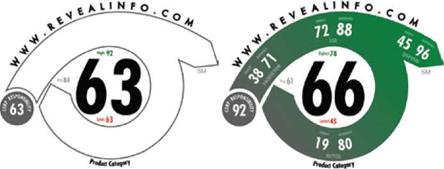I’ve learned a lot about rating and labeling systems working on my own solution. Beginning in 2002, I started designing label solutions for making the complex criteria involved across the sustainability spectra clear for consumers in a shopping environment. My aim was to make it easy to compare products and services in the same categories, while still being informative and imparting a sense of validity to the data presented. Over the next four years, I developed a series of labels to do just this—the Reveal Rating system (named by a colleague at school), as shown in Figure 17.2. In addition, while at
|
LEFT IMAGE: /Я http://flickr. com/photos/rosenfeldmedia/3273315644 RIGHT IMAGE: /И http://flickr. com/photos/rosenfeldmedia/3272513385 |
figure 17.2
The Reveal system is designed to grow over time (from the Phase 1 seal to the Phase 2 seal) as LCA (Life Cycle Analysis) data becomes available.
business school, I used this project as my thesis and quickly found that the label portion of the design was just the beginning of the solution.
More critical (and complex) was the system behind the label that collected, stored, and rated the data necessary to track performance across so many criteria. The system is, necessarily, vastly more complex than what appears on the label, but it is where the real design challenge lies. In particular, I found that the sources of data were critical, as well as who stored and validated it, and which parts were made available for use. The system itself is what needs to be designed, and it needs to balance needs and concerns among a variety of stakeholders in order to be effective and to address those very same stakeholders’ concerns as a prerequisite for participation.
The system needs to be available to business, organizations, and individuals in a variety of ways. For example, there is a lot of excitement for mobile phone applications that allow shoppers to call up ratings while in the grocery aisle.
However, my research showed that, while exceedingly modern and cool, most shoppers simply weren’t going to do this. Kiosks can provide another important interface for some shoppers, but the best solution was to get the labels right on the products themselves (alongside nutrition facts and other information).
This is probably too much to hope for anytime soon—at least across a wide range of manufacturers. The next best interface, however, is to get the labels onto the store shelves, right next to the price tags. In order to be effective, any system attempting to provide this information must work across this variety of interfaces in order to offer shoppers the best solution for each person or context.
But this was still only part of the solution. In order to make this kind of system a reality, the next step was to develop a business model around it so that it could be financially self-sustaining. One of the issues here was that most start-ups require significant investment, and investors almost always want huge returns in a quick time frame (three to five years). Otherwise, they’ll put their money in other promising investments (like clean energy technology). In addition, investors want a certain amount of liquidity, which usually comes from an IPO (Initial Public Offering)—something that probably isn’t well suited to this kind of organization— or a buyout from a large corporation. (This is something that would likely invalidate ratings from the service since there would be inherent conflicts of interest for that company’s products and services, as well as its competitors.)
These are some of the complexities around measurement systems that have, so far, prevented standards from emerging. The returns, however, are staggering. Probably more than any other innovation, rating and labeling systems can influence the most change faster than any other solution. The SROI calculations for merely three products, over 10 years, show billions of dollars in influence.
For now, designers and developers are on their own until standards emerge. Some existing standards can be used as a starting point, but
most will fall short of some critical criteria concerning an organization’s interests. Overcoming these challenges will require time and effort, but these solutions will pay off as organizations use metrics they develop to increase their operational, market, and financial performance over time. Not having a system of metrics only ensures that sustainable performance won’t be measured and most likely won’t be addressed.
Some of the challenges for creating a custom metric include the following:
• All stakeholders need to be aligned in mission and values (as closely as possible).
• Corporate strategies must support sustainability and be measured against sustainable gains.
• Not all performance can (or should) be measured in dollars. Some may need to stand on their own merits—such as social issues. [81]
them separate keeps decisions about each (and their inter-influence) separate as well.
• There is no perfect system so metrics should be introduced, in beta form, quickly to speed organizational learning that will improve the metrics themselves. Waiting until a system is complete is going to be a long wait.
• Experts can help develop these systems more quickly if their participation isn’t threatening to the organizations.
• Organizations need to put aside competitive pressures at this level and work together to establish more complete standards quickly. Companies can compete over performance according to the standards later, but until there is a standard, there’s no way to compete effectively. The standard itself can’t be an organization’s competitive strategy.
• Funding for metrics must become a priority, as well as implementation and education throughout the organization.
CHAPTER 18




